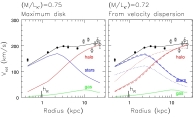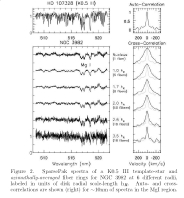 Stellar Kinematics of Nearby Galaxies
Stellar Kinematics of Nearby Galaxies Stellar Kinematics of Nearby Galaxies
Stellar Kinematics of Nearby GalaxiesCollaborators: M. Verheijen, K. Westfall, R. Swaters, D. R. Andersen
To answer the question on the mass of galaxy disks we have formed a collaboration to make direct, kinematic measures of the disk-mass of 40 nearly face-on spiral galaxies. These galaxies are of intermediate to late type, with regular gas kinematics. The primary measurement is based on the vertical component of the stellar velocity dispersion. The galaxies are being observed both in Ha and in the MgI (515nm) and CaII (860nm) spectral regions with SparsePak and the Bench Spectrograph on the WIYN 3.5m telescope, and with PPAK and PMAS on the Calar Alto 3.5m telescope. The Ha survey and sample selection is described here. Below we focus on the activities and highlights of our stellar kinematic observations and analysis reported in the 5 publications listed at the bottom of the page. The figure to the left shows our internal web-page for this survey, designed and maintained by R. Swaters.
We have measured the asymmetric drift in several galaxies in our survey. A direct consequence of the velocity dispersion of stars within galaxy disks is the asymmetric drift, i.e., the difference between the tangential velocity of the stars relative to the circular speed. The latter is typically well-traced by the gas because it is collisional. Measurement of the asymmetric drift is important both as a potential surrogate for measuring the stellar velocity dispersion, but also to correct the observed velocity dispersion for line-of-sight projections. Since the asymmetric drift is proportional to the radial component of the velocity dispersion, it can be used to derive a more accurate estimate of the vertical component. The figures below show (left to right) the overlay of SparsePak on a nearly face-on Ursa Major cluster member, NGC 3982); the derived Ha velocity field; the stellar velocity field (based on CaII); and the position-velocity diagrams for stars and gas for N3982 and another UMa spiral NGC 3949. It is the difference between the two velocities (stars vs gas) that is directly related to the asymmetric drift.
(b) Stellar LOSVDs vs radius:
 We have measured the
line-of-sight velocity dispersion (LOSVD) in both MgI and CaII
spectral regions in NGC 3982. A demonstration of the
azimuthally-averaged SparsePak spectra and their cross-correlation
peaks with a K0.5 III stellar template are shown to the left. These
are the primary data used to constrain the mass of the disk of N3982
(see below). Note the high quality (S/N) of the spectra out to large
radii (3-4 disk scale-lengths). This is a result of the high
surface-brightness of this galaxy, plus our ability to co-add many
fibers (up to 18) in a ring to make a azimuthally-averaged spectrum.
This technique is particularly tractable using face-on galaxies. By
using a large spectral library of template stars, combined with our
observations at two distinct wavelengths, we are able to explore (a)
the effects of template mismatch on the derived LOSVDs; and (b) the
extent to which there are significant differences in the LOSVDs for
different stellar populations within the disk.
We have measured the
line-of-sight velocity dispersion (LOSVD) in both MgI and CaII
spectral regions in NGC 3982. A demonstration of the
azimuthally-averaged SparsePak spectra and their cross-correlation
peaks with a K0.5 III stellar template are shown to the left. These
are the primary data used to constrain the mass of the disk of N3982
(see below). Note the high quality (S/N) of the spectra out to large
radii (3-4 disk scale-lengths). This is a result of the high
surface-brightness of this galaxy, plus our ability to co-add many
fibers (up to 18) in a ring to make a azimuthally-averaged spectrum.
This technique is particularly tractable using face-on galaxies. By
using a large spectral library of template stars, combined with our
observations at two distinct wavelengths, we are able to explore (a)
the effects of template mismatch on the derived LOSVDs; and (b) the
extent to which there are significant differences in the LOSVDs for
different stellar populations within the disk.
(c) Mass decomposition and disk M/L:
We have completed an analysis of the disk surface-mass density, and run of mass-to-light ratio with radius for NGC 3982. This has allowed us to uniquely decompose the rotation curve of this galaxy into its dark, gaseous-disk, and stellar-disk mass components. (Here we have assumed there is no significant contribution from molecular as or exotic disk dark-matter). This disk turns out to be near maximal, perhaps unsurprising because it is very high surface-brightness. The implied halo profile is consistent with an "isothermal halo" distribution, although it may be somewhat shallower in the center. The surface mass density of the disk is above the value at the Solar Radius in the Milky Way out to over 3 disk scale-lengths in this galaxy. The implied stellar M/L in the disk has a mean value of 0.75 (in the K band), and, despite radial color gradients, shows no significant radial trends. Remarkably, these dynamically-determined stellar M/L values and the B-K colors agree with simple population synthesis models. The model assumes a truncated IMF below 0.3MO. Better statistics are required to probe these models, and will be amply supplied with the completion of our survey.
The following figures (left to right) show the radial trends of the MgI and CaII region LOSVDs, derived surface-mass-density and M/L; the mass-decomposition using these dynamically determined disk mass densities; and a comparison of the observed B-K colors and disk M/L with simple population-synthesis models.
SparsePak: A Formatted Fiber Field-Unit for The WIYN Telescope Bench Spectrograph. II. On-Sky Performance, Bershady, M. A., Andersen, D. R., Verheijen, M. A. W., Westfall, K. B., Crawford, S. M., Swaters, R. A. 2003, submitted to ApJSupp. Funded under AST-0307417.
The Disk Mass project; science case for a new PMAS IFU module, Verheijen, M., Bershady, M., Andersen, D., Swaters, R., Westfall, K., Kelz, A., Roth, M.-M. 2004, AN, 325, 151 (preprint: [astro-ph/0311555]) Funded under AST-0307417.
Measuring Galaxy Disk Mass with the SparsePak Integral Field Unit on WIYN Verheijen, M., Bershady, M., Andersen, D. 2003, in proceedings of the ESO Astrophysics Symposium "The Mass of Galaxies at Low and High Redshift," eds. R. Bender & A. Renzini, (Springer-Verlag, Berlin), p. 221 (reprint: [UW reprint], [astro-ph/0201354]).
WIYN Integral-Field Kinematics of Disk Galaxies, Bershady, M., Verheijen, M., Andersen, D. 2002, in Disks of Galaxies: Kinematics, Dynamics Perturbations, eds. E. Athanassoula & A. Bosma, ASP Conference Series, 275, 43 (reprint: [local ps], [astro-ph/0201407])
| |
|
|
|